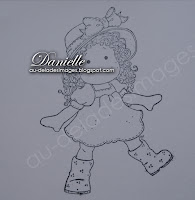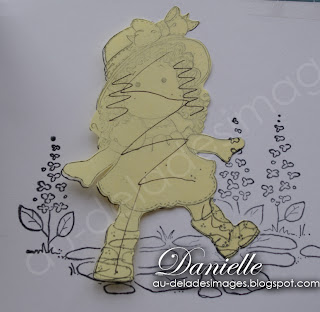You will find an english translation below the french text.
Je vous présente aujourd'hui un petit tutoriel d'une technique d'étampage que j,aime beaucoup: la superposition d'image, qui consiste à masquer une image déjà imprimée, pour étamper par dessus.Vous aurez besoin du matériel suivant:
Happy Wednesday,
I would like to offer you a little tutorial I have prepared within my DT projects, for Scrapbook ta vie. the original french text is on the boutique blog, but I have made an english version for you. I will give you a step by step method to print images one of top of the other, it is called the mask technique, and is one I love very much and used on the the image above. You will need the following:.
1. Stamp a ma jig ( or a home made one in lego pieces)
2. une feuille de plastique transparente et assez rigide (je me sers de tapis de coupe transparent achetés chez dolorama) ( carré coupé à angle droit - très important.
2. A tranparent plastic sheet, stiff enough, and cut square (important perfect 90 degrees angles)
3. vos étampes et 2 blocs d'acrylique de grandeur appropriée
3. Your 2 stamps, acrylic bloc
4. encre approprié pour la technique de coloriage
4. Ink selected for proper coloring technique
5. carton (x-press pour les copics, ou carton à médium sec, pour les crayons de bois)
5. Coloring cardstock (x-press or cryogen for copic, or cardstock for dry medium for coloring pencils)
6. un bloc post-it de grandeur 3 X5
6. Post-it size 3 X 5, or ECLIPSE paper (which is made by judikins, and is a sticky removable paper)
7. des ciseaux, du papier collant, Scotch amovible.
7. cissors, and Scotch removable tape
Avant de poursuivre... pour celles qui n'ont pas de stamp a ma jig (qui est un positionneur d'étampe à angle droit, vous pouvez facilement vous en fabriquer un avec des blocs lego; il est important de remplir 2 conditions: un angle droit parfait, et une hauteur et longueur raisonnable pour permettre à l'étampe de s'appuyer confortablement sur ses côtés,pour ne pas bouger.)
Before going on with my explanations, I have indicated above a link where you can see how to make a stamp a ma jig, with lego. This is a tool that has a 90 degree angle, and will help position your stamp.
1. La première étape consiste à positionner vos étampes sur vos blocs d'acrylique, j'insiste sur ce point, car un coup vos étampes placées, il est important de ne plus les déplacer. Je veux créer un arrière plan pour ma Tilda, alors, je vais tout d'abord faire un essai, pour avoir une idée de l'emplacement de mes images une sur l'autre, comme dans l'image qui suit.
1. the first step consists in positioning your stamps on acrylic blog, I am insisting on this point, so you do not move your stamps once they are positioned on the block. To see what kind of scenery I want to create, I stamp both images one on top of the other, to have an idea of the place each stamp will occupy on my cardstock. refer to the picture below.
2. Puis, je vais imprimer l'image que je souhaite entière, donc au premier plan, sur le post it, en prenant soin de garder le plus d'espace de colle possible. Ici, ce sera Tilda, et je la positionne le plus possible près de la bordure collante. Puis je découpe tout autour de l'image, le plus près possible des lignes. réservez, ceci est un masque.
2. I will stamp the image I want complet on the the post it, in this case, it is tilda, making sure I will keep the most sticky part. (If you use the Eclipse tape, you will not need to worry). then, I cut all around Tilda, close to the lines. This will be my mask.
3. I will then print the back ground image on my plastic sheet using the stamp a ma jig. As shown below. I will get my background image, in trasparency, making it easy to position on my final print.
4.Tous mes éléments sont maintenant prêts pour imprimer mon image en version finale. Ce qu'il faut se rappeler, c'est de procéder selon les règles de perspective, imprimer le premier plan,
4. All my elements are now ready, to start printing my final version. What has to be remembered, is to proceed according to perspective rules ( print the closest image first, and then go on...)

puis protéger cette image, tel que montré sur la photo ci haut, au moyen du post it que nous avons préalablement imprimé et coupé.
After printing Tilda, as seen on the above picture, cover her with the post it.
L,étape suivante consiste à postionner l'image de fond, imprimée sur la feuille transparente, à l'endroit désiré. Avant de se faire, un petit truc, pour éviter que notre image se déplace, je colle un coin au moyen d'un ruban collant AMOVIBLE (c'est le Scotch dont le distributeur est de couleur bleu)
We will now position the background image on top of tilda (which should have been covered with the mask). To make sure the image does not move, stick a tiny piece of stoch tape at the coner of the carstock.
We will now position the background image on top of tilda (which should have been covered with the mask). To make sure the image does not move, stick a tiny piece of stoch tape at the coner of the carstock.
Maintenant, positionner le Stamp a ma jig au coin de la feuille de platique, puis retirez la, sans bouger le positionneur. retirez la feuille de plastique, et replacez la par le bloc d'acriclique sur lequel est placé l'étampe de fond.
When you are satisfied with the emplacement of the background image, postion the stamp a magic as seen below, at the corner of the plastic sheet. Then, remove the plastic sheet, and simply position the acrylic bock at the right corner, and stamp the image.
When you are satisfied with the emplacement of the background image, postion the stamp a magic as seen below, at the corner of the plastic sheet. Then, remove the plastic sheet, and simply position the acrylic bock at the right corner, and stamp the image.
Voilà... sur cette photo, vous pouvez voir où l'étampe a imprimé sur les bottes de tilda et sur sa main.
On the picture below, you can see where the background image overlaps on tilda.

5. Enlevez le post it, et vous êtes maintenant prête à colorier votre image.
5. Remove the post it, and you are now ready to color the image.
6. Si vous aviez voulu imprimer une autre image en superpostion, au 3e plan, il aurait suffit de masquer Tilda, ainsi que la 2e image, et d'imprimer votre 3e image sur une feuille transparente, et de répéter les étapes.
6. You could have printed a 3rd image, behind tilda and the first background. All you would have to do is make a 2nd mask for the flower background, and stamp the 3rd image over all the masks.
Voici mon image coloriée.
this is my colored image.
this is my colored image.
Et la carte sur laquelle je l'ai utilisée.
And the card on which I used it.
And the card on which I used it.
J,espère que cette petite technique vous a plu, et que vous tenterez l'expérience dans vos prochaines créations. A bientôt.
I hope you enjoyed this little tutorial, and it will make it easier for you to experiment this little technique.












11 commentaires:
Danielle, c'est un super beau tutorial!!! Très détaillé avec beaucoup de photo! Merci, Brigitte
Hi Danielle!
What a PERFECT tutorial! I loved it! You explain things SO clearly and thoroughly and make things EASY! :) Simply FABULOUS tutorial my dear!!!! You ROCK!
Much Love,
Elise
Danielle!!! Fantastic tutorial!!! Thanks a lot for sharing!!!
Hugs
Regina
C'est cette technique que j'utilise et c'est vraiment facile.
Tu nous la présente de façon très explicite et facile à comprendre.
Oh my gosh, sweetie! Your card is breathtaking!!!! Your coloring is out of this world gorgeous, and I love the papers and colors you used! You're just a little bundle of huge talent!!! LOOOOVE it!!!
hugs, Sharon
ta carte est fabuleuse Danielle, merci pour le tuto je ne connaissais pas cette idée de transparent et de "guide"!
bises
céline
Absolutely gorgeous Danielle! I love these two images together, they make a great scene, Beautifully done!
Great tutorial too
Hugs Julie P
Your card is absolutely BREATHTAKING....MAGNIFICENTLY COLORED TILDA!!!!! WOW!!!!!!!
Excellent job with the tutorial.
Fabulous!! Thanks so much for this tutorial.
Thank you so much Danielle for the tutorial - I sure hope you do more. As you and I both know, you are and artist and wonderful teacher!
XO
Sandy
Bravo Danielle! Cette petite Tilda est une pure merveille et ta colorisation, toute en douceur.
Merci pour tes conseils.
Bises
Marie
Enregistrer un commentaire